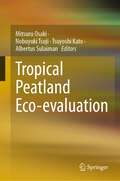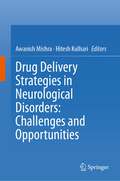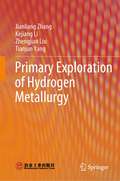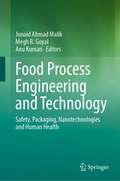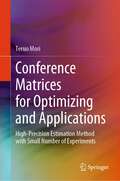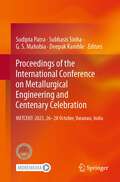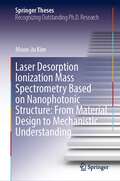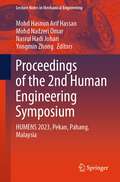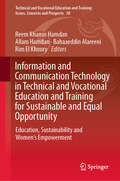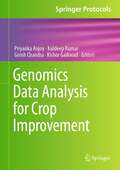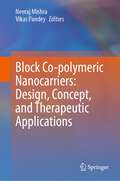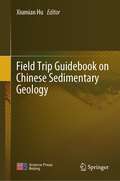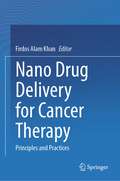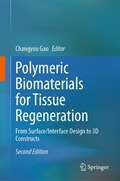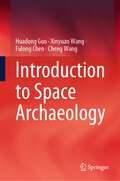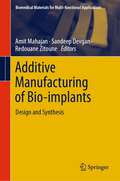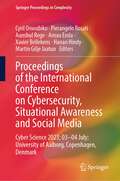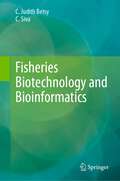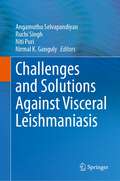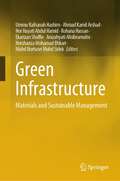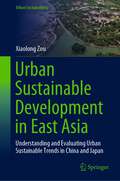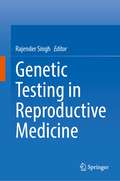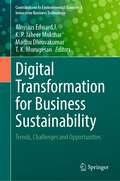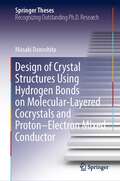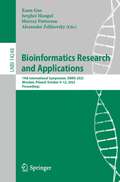- Table View
- List View
Tropical Peatland Eco-evaluation
by Mitsuru Osaki Nobuyuki Tsuji Tsuyoshi Kato Albertus SulaimanThis book focuses on eco-evaluation system monitoring and sensing, carbon-water modeling, mapping, and disaster prediction. It is the 3rd book on tropical peatland issues, following 1st "Tropical Peatland Ecosystem" and 2nd "Tropical Peatland Eco-management" publications. Tropical peatland is also a wetland, mangrove, and rainforest. With this nature, two major key elements of tropical peatland are water and forest. This book introduces the relationship and interaction among water, oxygen, and nutrients as well as aspects of the forest as the driving force of carbon stock and the carbon cycle. Eco-evaluation system is key to conserving, managing, and restoring tropical peatlands, however comprehensive system for Eco-evaluation in the Tropics is not yet established. This book reviews and proposes Eco-evaluation methods in the Tropics Ecosystem, focusing mainly on the peatland ecosystem and others, covering Social Capital such as Credit, Bonds, National Accounting, etc.
Drug Delivery Strategies in Neurological Disorders: Challenges and Opportunities
by Awanish Mishra Hitesh KulhariThis book comprehensively reviews the recent progress in their pathogenesis and management approaches for neurological disorders. It focuses on understanding the molecular mechanism, pathology, novel nanotechnology-based approaches against stroke, Alzheimer’s disease, Parkinson disease, Huntington’s disease, Multiple sclerosis, and Epilepsy. The book provides the basic understanding about the development and progression of these diseases, and recent pharmacotherapeutic approaches for their management. It also discusses challenges in drug development for neurological disorders, including preclinical models of disorders, the need for drugs to cross the blood-brain-barrier, and limited understanding of relevant pathophysiology. The book also focuses on different conventional and novel strategies for drug delivery in neurological disorders. Towards the end, the book reviews the applications of nanotechnology for the diagnosis of neurological disorders. One of the chapters is focused onthe role of herbal actives in the treatment of neurological disorders. Finally, a chapter is included on nanotechnology-based approaches for diagnosis of neurological disorders. This book is a useful resource for students and researchers of pharmaceutical sciences, life sciences, material sciences, and nanosciences.
Primary Exploration of Hydrogen Metallurgy
by Jianliang Zhang Kejiang Li Zhengjian Liu Tianjun YangThis book is a monograph dedicated to hydrogen metallurgy technology in iron ore reduction in the world (mainly in China), aiming to accelerate the development of hydrogen metallurgy research and promote the low-carbon process in the iron and steel industry. This book mainly introduces the frontier theory and process technology of hydrogen metallurgy, focusing on the behavior and role of hydrogen in reducing iron ore. The specific contents include hydrogen production and storage technology, hydrogen direct reduction of iron oxide technology, hydrogen smelting reduction of iron oxide technology, plasma hydrogen reduction of iron oxide theory, and the behavior of hydrogen in blast furnace iron-making and sintering processes. This book provides a comprehensive and detailed description of the theories and process technologies involved in hydrogen metallurgy at the levels of fundamental theory, feasibility analysis, experimental studies, and industrial applications. This book can be usedas a reference for metallurgical engineering, iron, and steel metallurgy majors, as well as teachers and students, researchers, engineers, and enterprise staff interested in hydrogen and low-carbon metallurgy-related fields.
Food Process Engineering and Technology: Safety, Packaging, Nanotechnologies and Human Health
by Junaid Ahmad Malik Megh R. Goyal Anu KumariThis book focuses on novel technologies related to food processing technology and engineering. It also focuses on food safety, quality and management, the scope of the Internet of Things (IoT) in food processing and its management, bioengineering tools for crop improvement in agriculture, recent innovations in food packaging, nanotechnology in food processing, and the nutritional health benefits of food. 3D printed food, an interesting and increasingly popular concept among the public today, is a meal prepared through an automated additive process using 3D food printers. This book is a ready reference for food researchers, students, and industry professionals. The book updates the current scenario of food processing technology and engineering for readers from agriculture and its allied fields including students and researchers of food science and technology, dairy science and technology, packaging industry, people working in food safety organisations, and researchers in the field of nanotechnology.
Conference Matrices for Optimizing and Applications: High-Precision Estimation Method with Small Number of Experiments
by Teruo MoriThis book describes many types of Conference matrices and shows the case studies of application. Also, this book deals with putting the operation procedure and data analysis for optimizing. After reading this book, many researchers in universities or industries directly can apply various methods in this book to researching subjects. And it saves the trial numbers, cost and time around 1/3–1/2 in total research activities. Especially, this book contributes SDGs and saving GLOBAL warming which need to countermeasures as well.
Proceedings of the International Conference on Metallurgical Engineering and Centenary Celebration: METCENT-2023, 26-28 October, Varanasi, India
by Sudipta Patra Subhasis Sinha G. S. Mahobia Deepak KambleThis book presents peer reviewed articles from The International Conference on Metallurgical Engineering and Centenary Celebration (METCENT 2023), held at Indian Institute of Technology (BHU) Varanasi, India from the 26-28th of October 2023. It covers wide areas of metallurgical and materials science, highlighting recent advancements in these areas, including but not limited to Advanced Steels, Computational Material Science, Recent Ferrous/Non-Ferrous Metallurgy Processes, Green Iron and Steel Making Technologies and others. METCENT 2023 provides a unique opportunity to all the Metallurgists, Materials Scientists, Academicians and Industry experts to share their experiences on this special occasion.
Laser Desorption Ionization Mass Spectrometry Based on Nanophotonic Structure: From Material Design to Mechanistic Understanding (Springer Theses)
by Moon-Ju KimThis book presents innovative laser desorption ionization (LDI)-active nanophotonic structures for addressing the challenges that matrix-assisted laser desorption ionization mass spectrometry (MALDI-MS) is currently facing and for enhancing LDI efficiency. It presents a variety of cutting-edge nanophotonic structures to satisfy the mass-analytical needs of sensitivity, reproducibility, and quantification. As opposed to the commercialized, conventional organic matrix used in MALDI-MS, these nanostructures are validated to be highly effective in detecting small metabolites and drugs, highlighting their considerable potential in the mass spectrometry field. It also systematically elucidates fundamental LDI processes in terms of the photo-thermal, electronic, and structural characteristics of nanophotonic structures, offering mechanistic knowledge of LDI-MS. Even though LDI-MS performance is heavily influenced by a number of nanostructure parameters, relatively little is known about the LDI processes associated with those characteristics. An in-depth understanding of nanostructure characteristics and LDI mechanisms thus paves the way for more effective, rational design and development of nanostructures with improved LDI capabilities. Further, with a focus on multiple cascades in nanostructure functions in response to laser pulse stimuli, this book provides detailed, step-by-step procedures to design and construct a nanophotonic, LDI-active platform, which may serve as a roadmap for graduate students in the field of mass spectrometry. Readers, including graduate students, researchers, and experts working in the related areas of mass spectrometry, nanophotonics, and material science and material engineering, will find a wealth of useful information in this book.
Proceedings of the 2nd Human Engineering Symposium: HUMENS 2023, Pekan, Pahang, Malaysia (Lecture Notes in Mechanical Engineering)
by Mohd Hasnun Arif Hassan Mohd Nadzeri Omar Nasrul Hadi Johari Yongmin ZhongThis book acts as a compilation of papers presented in the 2nd Human Engineering Symposium (HUMENS 2023), held at Pekan, Pahang, Malaysia. The symposium covers the following research topics: ergonomics, biomechanics, sports technology, medical device and instrumentation, artificial intelligence / machine learning, industrial design, rehabilitation, additive manufacturing, modelling and bio-simulation, and signal processing. The articles published will be of interest to researchers and practitioners from the medical device manufacturers, healthcare, rehabilitation and sports technology.
Information and Communication Technology in Technical and Vocational Education and Training for Sustainable and Equal Opportunity: Education, Sustainability and Women Empowerment (Technical and Vocational Education and Training: Issues, Concerns and Prospects #38)
by Allam Hamdan Bahaaeddin Alareeni Reem Khamis Hamdan Rim El KhouryThis book provide an in-depth analysis of current development concerning ICTs with reference to vocational education and training. It presents best and innovative ICT-based solutions implemented in education and explores controversial topics such as challenges and opportunities. It discusses the role of ICT, vocational education and training in women empowerment. It also examines digital learning, vocational education and sustainable operations. Information and communication technologies have created new opportunities along with new challenges, putting profound and urgent implications on vocational education and training (VET). Nowadays, we must think broadly and make the right choices about VET using innovation and digitalization to boost the quality of vocational education and training, enable the upskilling and reskilling of adults, and enhance the employability of learners. The potential and the impact of ICTs in vocational educationand training have yet to be fully exploited, leading to an emerging direction of research. This book helps readers to understand the idea of business education and education governance in a digital age. It is of interest to practitioners, administrators, researchers, teachers, teacher educators and students.
Genomics Data Analysis for Crop Improvement (Springer Protocols Handbooks)
by Priyanka Anjoy Kuldeep Kumar Girish Chandra Kishor GaikwadThis book addresses complex problems associated with crop improvement programs, using a wide range of programming solutions, for genomics data handling and sustainable agriculture. It describes important concepts in genomics data analysis and sequence-based mapping approaches along with references. The book contains 16 chapters on recent developments in several methods of genomic data analysis for crop improvements and sustainable agriculture, all authored by eminent researchers who are experts in their fields. These chapters focus on applications of a wide range of key bioinformatics topics, including assembly, annotation, and visualization of next-generation sequencing (NGS) data; expression profiles of coding and noncoding RNA; statistical and quantitative genetics; trait-based association analysis, quantitative trait loci (QTL) mapping, and artificial intelligence in genomic studies. Real examples and case studies in the book will come in handy when applying the techniques. The relative scarcity of reference materials covering bioinformatics applications as compared with the readily available books also enhances the utility of this book. The targeted readers of the book are scientists, researchers, and bioinformaticians from genomics and advanced breeding in different areas. The book will appeal to the applied researchers engaged in crop improvements and sustainable agriculture by using bioinformatics tools, students, research project leaders, and practitioners from the various marginal disciplines and interdisciplinary research.
Block Co-polymeric Nanocarriers: Design, Concept, and Therapeutic Applications
by Neeraj Mishra Vikas PandeyThis book focuses on current advancements in the field of block copolymers and covers design, concept, and various therapeutic applications in the drug delivery. It also reviews the use of block copolymers in drug delivery applications from the development of sustained release products to smart polymeric delivery systems such as stimuli-responsive polymeric systems, for example, thermosensitive, redox-sensitive, photo-sensitive, and enzyme-sensitive. The book further discusses the nano assemblies from amphiphilic block copolymers as nanomedicine platforms for diagnosis and therapy due to their relatively small size, high drug loading capacity, controlled drug release, in vivo stability, and prolonged blood circulation. The chapters also review the various patents and ongoing clinical trials on the applications, covering several important new concepts and findings in the field of block copolymers. The book is aimed at researchers, academicians, and industrial scientists involved in the development of drug-delivery systems based on polymers.
Field Trip Guidebook on Chinese Sedimentary Geology
by Xiumian HuThis book provides diversified and comprehensive sedimentary, stratigraphic, and paleontological information services in China both for scientific research and educational purposes. Although China has the largest number of 11 “golden nails” profiles in the world, few of them has internationally renowned profiles with only traditional sedimentary methods and means for outcrops, logging, and seismic analysis. It combines multiple disciplines such as sedimentology, stratigraphy, paleontology, geophysics, geochemistry, and methods such as big data and artificial intelligence to build open-source online digital platform of geological profiles. Based on the preparation and construction of a number of well-known classic sections of sedimentary geology at home and abroad, it has become an important platform for training of sedimentology talents.
Nano Drug Delivery for Cancer Therapy: Principles and Practices
by Firdos Alam KhanThis book discusses the various modes and methods of nano-based drug delivery in different types of cancers such as colon, breast, cervical, ovarian, and lung cancer. It reviews the significance of nano drug delivery in cancer therapy, the application of nanoparticles in overcoming drug resistance, targeted therapy, and immunotherapy. The book also covers topics related to the synthesis of different types, shapes, and sizes of nanocarriers using synthetic and biological approaches. Further, a chapter explores the synthesis of nanocarriers loaded with anti-cancer drugs by using functionalization or conjugations and encapsulation methods. The book also examines the nanocarriers as delivery vehicles for chemotherapeutic agents against cancers using in vitro and animal models of cancers, preclinical trials for efficacy, and safety profiling of nanocarriers. Finally, future trends and innovation in nano drug delivery for cancer therapy, application of siRNA (nanoparticle-based RNA) therapy, ultrasound-linked nano-cancer therapeutics, and application of exosome-based cancer therapy topics are discussed. Towards the end, the book examines the limitations of nanocarriers, including the cell and tissue toxicity, genotoxicity, and scale-up of nanomaterials, health and environmental hazards associated with nanoformulation synthesis, respiratory diseases, government regulations, and ethical issues.
Polymeric Biomaterials for Tissue Regeneration: From Surface/Interface Design to 3D Constructs
by Changyou GaoThis book reviews state of the art of polymeric biomaterials for regenerative medicine and highlights advances in both fundamental science and clinical practice. It summarizes the latest techniques in polymeric scaffold fabrication, delivery carriers, physiochemical property modulation, as well as their influence on the adhesion and performance of biomolecules, cells, and tissues. It also describes methods for creating biofunctional surfaces/interfaces and subsequently modulating the host response to implantable materials. Lastly, it discusses the applications of biomaterials and constructs in soft-tissue regenerative medicine. It is a valuable resource for materials scientists and engineers wishing to identify research priorities to fulfill clinical needs and provides physicians with insights into emerging novel biomaterials. This integrated approach also offers engineering students a sense of the relevance of materials science in the development of novel therapeutic strategies. In the second edition, most of the chapters are updated according to the latest progress of this research field. A new chapter on nerve regeneration is also included.
Introduction to Space Archaeology
by Huadong Guo Xinyuan Wang Fulong Chen Cheng WangThis book presents the basic principles and the latest advances in space archaeology. Following general reviews of the state of the art of Earth observation technologies and archaeology, the book introduces the principles and methods of space archaeology, remote sensing methods for archaeological survey, and integrated archaeological survey methods including geophysics, virtual reality, web technologies, global positioning systems (GPS), geographical information systems (GIS), and big data. The book then presents two chapters on case studies of word heritage sites in Asia, Europe, Africa, and Americas, including three major world heritage sites in China: The Great Wall, Grand Canal, and Silk Road. The last chapter of the book discusses the future of space archaeology. This book has an interdisciplinary appeal and scholars with an interest in cultural heritage and remote sensing technologies for Earth value its contribution.
Additive Manufacturing of Bio-implants: Design and Synthesis (Biomedical Materials for Multi-functional Applications)
by Amit Mahajan Sandeep Devgan Redouane ZitouneThis contributed volume presents the latest research on additive manufacturing (AM) or 3D printing, one of the key techniques of novel medical devices, which can process complicated or customized structures to match the properties of human tissues. AM allows for the fabrication of devices with optimal architectures, complicated morphologies, surface integrity, and regulated porosity and chemical composition. Various AM methods can now consistently fabricate dense products for a variety of materials, comprising steels, titanium alloys, Co-Cr alloys, metal-based composites, and nanocomposites. This book elucidates the chronology of various techniques that are categorized under additive manufacturing. Moreover, the futuristic techniques or advancements in this area are also described. The available literature focuses on the microstructure and various properties of 3D-printed alloys. However, the research on the wear characteristics, corrosion resistance, and biocompatibility of 3D-printed technology for biomedical applications is limited. This book comprises the helicopter view of different surface analysis trends of additive manufactured alloys. The book can be a valuable reference for beginners, researchers, and professionals interested in bioimplant manufacturing and allied fields.
Proceedings of the International Conference on Cybersecurity, Situational Awareness and Social Media: Cyber Science 2023; 03–04 July; University of Aalborg, Copenhagen, Denmark (Springer Proceedings in Complexity)
by Cyril Onwubiko Pierangelo Rosati Aunshul Rege Arnau Erola Xavier Bellekens Hanan Hindy Martin Gilje JaatunThis book highlights advances in cyber security, cyber situational awareness (CyberSA), artificial intelligence (AI) and social media. It brings together original discussions, ideas, concepts and outcomes from research and innovation from multidisciplinary experts. It offers topical, timely and emerging original innovations and research results in cyber situational awareness, security analytics, cyber physical systems, blockchain technologies, machine learning, social media and wearables, protection of online digital service, cyber incident response, containment, control and countermeasures (CIRC3). The theme of Cyber Science 2023 is multidisciplinary and multidimensional cyber security. And through call for papers, we solicit original contributions advancing research in artificial intelligence, machine learning, blockchain, cyber security, social media, cyber incident response and cyber insurance.
Fisheries Biotechnology and Bioinformatics
by C. Judith Betsy C. SivaThis authored book is focused on SDG 14: Life below water, comprehensively addressing all facets of biotechnology and bioinformatics related to fisheries. It offers an extensive exploration of the detail on structure, function and types of nucleic acids, concepts of gene and genetic code, mutations, and their implications. The book provides essential information on gene regulation and expression in prokaryotes and eukaryotes. Step-by-step descriptions are provided for technologies such as gene transfer, rDNA, transgenic fish production, animal cell culture, hybridoma technology and cryopreservation technology in fishes. Special emphasis has been given to topics like RNA in gene regulation, epigenetics, and DNA and protein sequencing. Various molecular techniques and markers have been discussed in detail. Further, various topics on bioinformatics including different databases, formats, sequence retrieval, manipulation, analysis, primer design, molecular visualization, genomics, and proteomics are also covered. This volume will prove invaluable to aquaculturists, equipping them with essential techniques and protocols. It constitutes essential reading for students enrolled in aquaculture or fisheries courses within tropical and sub-tropical regions.
Challenges and Solutions Against Visceral Leishmaniasis
by Angamuthu Selvapandiyan Ruchi Singh Niti Puri Nirmal K. GangulyThis book comprehensively reviews the epidemiology and surveillance strategies of Visceral Leishmaniasis, and the latest developments in disease diagnosis, drug discovery, and vaccine development. The initial chapters cover the epidemiology features and spatial distribution of Visceral Leishmaniasis. The book further discusses the manifestations of HIV-Visceral Leishmaniasis infection on the immunopathogenesis, diagnosis, and therapeutic response. It analyzes the role of different proteomic technologies in understanding the parasite development, survival, drug resistance mechanisms, host-pathogen interactions, and the development of new therapeutic approaches. The book concludes by discussing recent advancements in vaccine development for Visceral Leishmaniasis. It discusses the promising vaccine candidate, their developmental status, current challenges, and prospects for rational vaccine development against Leishmania. This book is an invaluable source of information for students, and researchers working to understand the Leishmania biology, and drug development.
Green Infrastructure: Materials and Sustainable Management
by Ummu Raihanah Hashim Ahmad Kamil Arshad Nor Hayati Abdul Hamid Rohana Hassan Ekarizan Shaffie Anizahyati Alisibramulisi Norshariza Mohamad Bhkari Muhd Norhasri Muhd SidekThis second volume of "Green Infrastructure" provides a comprehensive exploration of both established and evolving green infrastructure materials, along with sustainable practices across various facets that hold the potential to shape our future. Emphasizing emerging domain materials such as timber, concrete, soil, and pavement, among others, this book delves into the pivotal role these elements play in fostering sustainable urban development. It underscores the significance of these materials in preserving ecosystem services and constructive management, thus leading to the attainment of manifold advantages. Bridging a critical void in the existing literature, this volume serves as an indispensable resource, serving to guide forthcoming research endeavors concerning green materials and their applications within the realm of sustainability.
Urban Sustainable Development in East Asia: Understanding and Evaluating Urban Sustainable Trends in China and Japan (Urban Sustainability)
by Xiaolong ZouThis book offers careful glimpse from the lenses of selected case studies of major counties in East Asia, namely China and Japan to obtain insights as well as lessons regarding their perspective sustainable cities development. Urban sustainability is the pillar domain for achieving overall sustainability. East Asia has the world most populous countries and cities; therefore, it is of great importance to understand, analyze, and assess the sustainable urban development trends and paradigms in an East Asia setting so as to better guide the future development of sustainable cities in the region. The outcomes of this book are policy-relevant consultations to key stakeholders from various walks of sustainability studies.
Genetic Testing in Reproductive Medicine
by Rajender SinghThis textbook illustrates the importance and significance of molecular genetic testing in reproductive disorders. The present book covers the genetic testing in various reproductive system anomalies, including disorders of sexual development, male infertility (Y deletions, autosomal mutations, sperm DNA fragmentation), female infertility (PCOS and POF), mitochondrial DNA testing for oocyte quality, recurrent pregnancy loss, pre-term birth, endometrial receptivity, prenatal genetic screening, reproductive carrier screening, preimplantation genetic screening, endometrial cancer, cervical cancer and other related reproductive health disorders. Microbiome testing and its contribution to genetic testing in reproductive medicine are also discussed. Genetic testing in some of these has already come into practice, genetic testing for others is established but not clinically practiced, and genetic testing for others is yet in infancy as there is only limited data available. For the disorderswhere sufficient genetic data to undertake genetic testing is not available, we have tried to put together the evidence for proposing such tests in the near future. Apart from this, the book also covers ethical, moral and technical challenges in genetic testing in reproductive medicine. The book aims to set up a standard with regard to genetic testing in the reproductive medicine field, encourage further data generation, and provide food for thought in the areas of lacunae. The book serves graduate students, researchers, clinicians, professors, and patients in the field of reproductive medicine.
Digital Transformation for Business Sustainability: Trends, Challenges and Opportunities (Contributions to Environmental Sciences & Innovative Business Technology)
by Aloysius Edward J. K. P. Jaheer Mukthar Madhu Dhruvakumar T. K. MurugesanThis book explores how digital technologies can be used to drive sustainable business practices and achieve long-term business success. It offers insights and practical strategies and guidance that can help businesses adapt to the digital age, optimize their operations, and create new opportunities for growth. The book further provides real-world examples that illustrate how businesses can leverage digital technologies to achieve long-term sustainability and success. The book is an essential read for business leaders, managers, academician, practitioners and entrepreneurs who are looking to drive sustainable digital transformation within their organizations. The book covers a wide range of topics, including:1) Understanding the digital landscape: The book provides an overview of the digital technologies that are transforming business operations, such as artificial intelligence, cloud computing, and the Internet of Things. It explores how these technologies can be leveraged to create sustainable business practices that benefit both the organization and society.2) Building a digital strategy for sustainability: The book offers guidance on how businesses can develop a digital strategy that aligns with their sustainability goals. It covers topics such as identifying digital opportunities, setting targets, and measuring performance.3) Embedding sustainability into digital operations: The book explores how businesses can integrate sustainability into their digital operations, such as data management, supply chain management, and product design. It provides examples of companies that have successfully implemented sustainable digital practices.4) Digital innovation for sustainability: The book discusses how businesses can use digital innovation to create new opportunities for sustainability. It covers topics such as circular economy business models, sustainable product design, and social innovation.5) Leading for sustainable digital transformation: The book offers insights on how business leaders can drive sustainable digital transformation within their organizations. It covers topics such as leadership skills, organizational culture, and stakeholder engagement.
Design of Crystal Structures Using Hydrogen Bonds on Molecular-Layered Cocrystals and Proton–Electron Mixed Conductor (Springer Theses)
by Masaki DonoshitaThis thesis addresses the design of crystal structures using hydrogen bonds. In particular, it focuses on the design of functionalities and the control over the packing of molecular assemblies, based on molecular designs.Firstly, the synthesis and evaluation of a proton–electron mixed conducting charge transfer salt is reported. Focusing on the difference in the strength of hydrogen bonds and weaker intermolecular interactions, a system was rationally designed and constructed where electron-conducting molecular wires were encapsulated within a proton-conducting matrix. Next, the investigation of structural phase transitions in a cocrystal consisting of hydrogen-bonded two-dimensional molecular assemblies is reported. Drastic rearrangements of hydrogen-bonded molecular assemblies in the cocrystal led to single-crystal-to-single-crystal phase transitions, resulting in anisotropic changes in the crystal shape. Furthermore, chemical modification of a component molecule in the cocrystal is reported. The modification afforded control over the stacking patterns of the two-dimensional molecular assemblies, i.e., sheets, and the mechanism was discussed considering the intersheet intermolecular interactions and molecular motion.It is suggested that hydrogen bonds are beneficial to construct molecular assemblies in molecular crystals because of their strength and well-defined directionality, and the consideration of coexisting weaker intermolecular interactions can lead to the design of whole crystal structures and, hence, functionalities. This thesis benefits students and researchers working on solid-state chemistry by presenting various methods for characterizing and evaluating the properties of molecular solids.
Bioinformatics Research and Applications: 19th International Symposium, ISBRA 2023, Wrocław, Poland, October 9–12, 2023, Proceedings (Lecture Notes in Computer Science #14248)
by Xuan Guo Serghei Mangul Murray Patterson Alexander ZelikovskyThis book constitutes the refereed proceedings of the 19th International Symposium on Bioinformatics Research and Applications, ISBRA 2023, held in Wrocław, Poland, during October 9–12, 2023.The 28 full papers and 16 short papers included in this book were carefully reviewed and selected from 89 submissions. They were organized in topical sections as follows: reconciling inconsistent molecular structures from biochemical databases; radiology report generation via visual recalibration and context gating-aware; sequence-based nanobody-antigen binding prediction; and hist2Vec: kernel-based embeddings for biological sequence classification.
